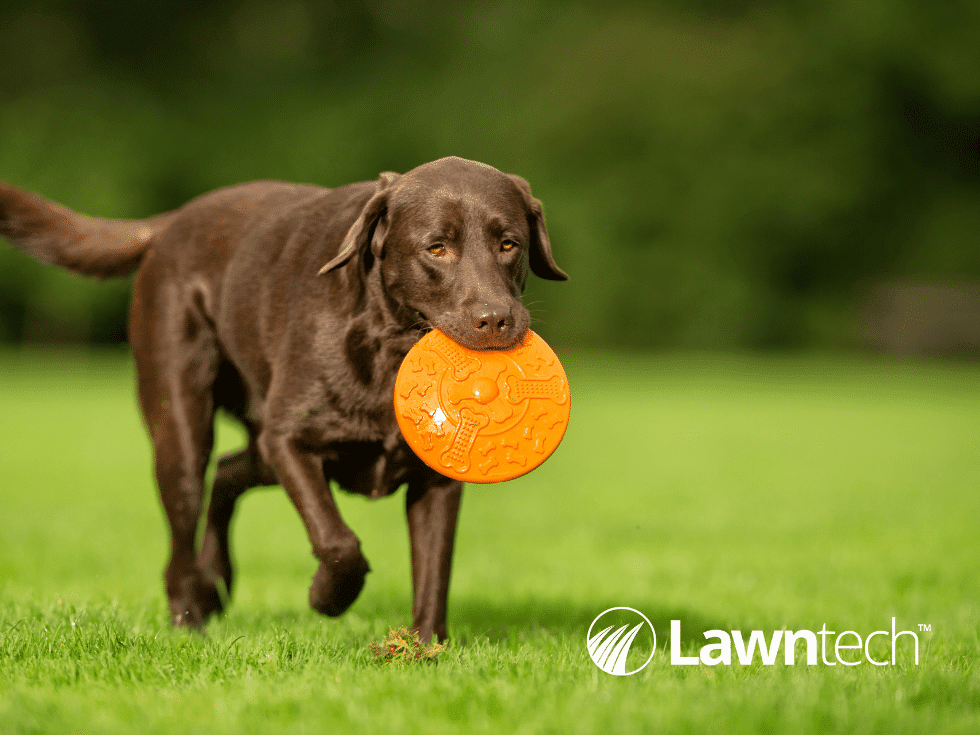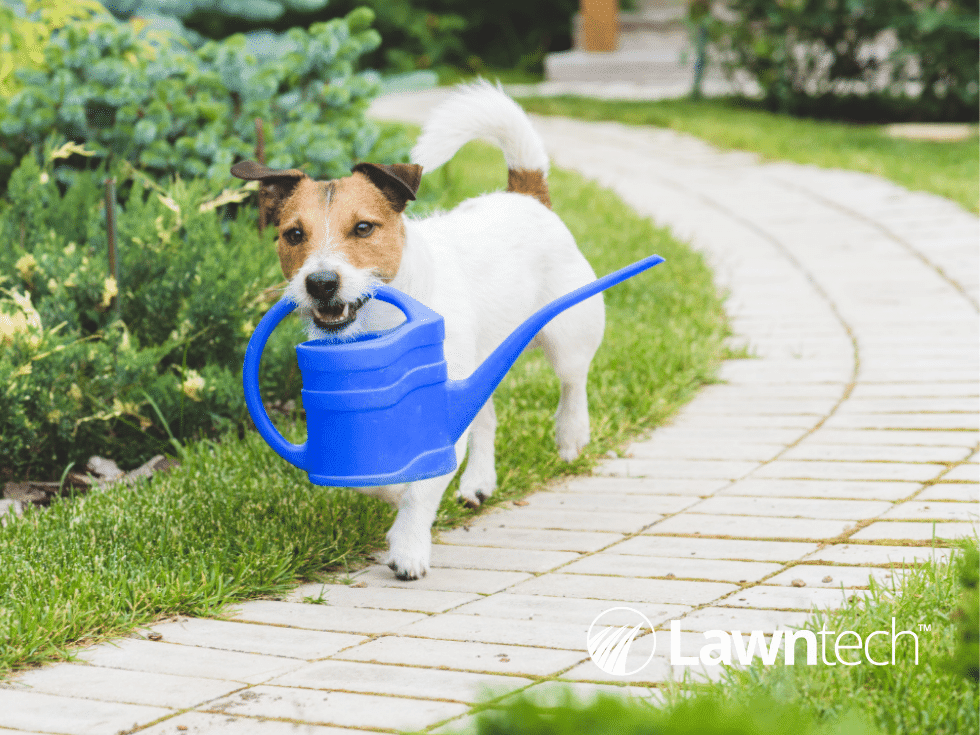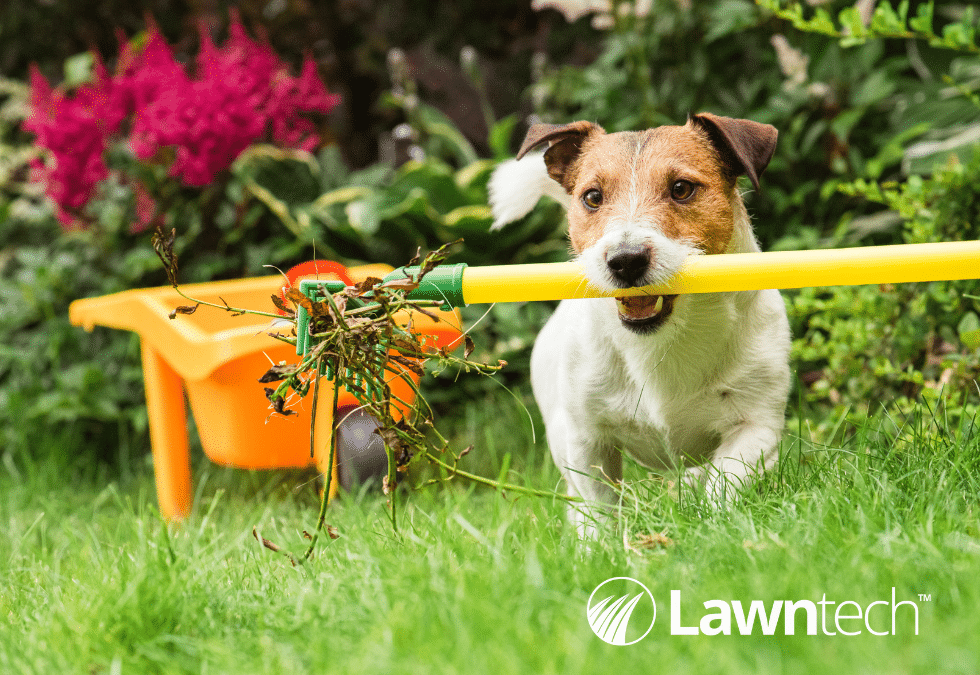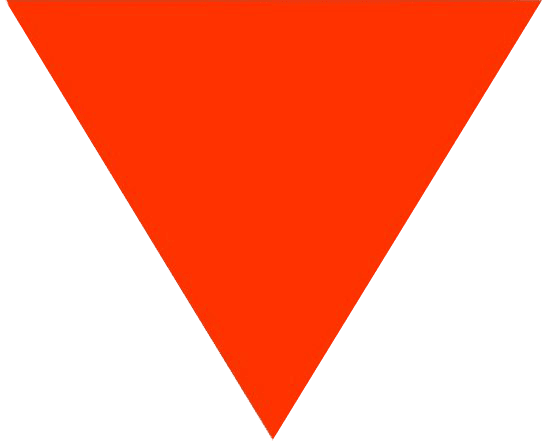It’s no secret that in the UK we are a nation of pet lovers; from pet fashion, pet passports to pet salons, they are very much a part of our home and families. So much so, that we dedicate 11th April as National Pet Day each year in celebration of our furry friends.
Here at Lawntech, we have a whole team of pet owners, and we know that our home and gardens are a sanctuary that we want to share with our pet companions, but we also understand the challenges our lawns face when we welcome pets to the family.
We’ve explored the key questions we often get asked regarding pets and your lawn.
Can I have a nice lawn with pets?
Although not impossible, there’s no doubt it is certainly challenging maintaining a healthy lawn when we have pets at home and dependent on the type of pet you have, their habits can affect your lawn’s condition in varying ways.

Small animals such as rabbits are often contained to one area of our garden which lessens damage to our lawns from munching and droppings on a much larger scale.
Our grass is a tasty food source for grazing animals such as guinea pigs, tortoises and rabbits. As they munch away at our lawn, they are damaging the grass plants and its growth. To prevent damage to the grass plants on a wider scale, it’s a good idea to dedicate a small section of your garden to these animals. This allows them to enjoy their own given space and any injury to the lawn, for example, from munching and droppings, will be confined to this one area which can then be dealt with once the enclosure is moved to its next location.
For our larger four-legged friends, they tend to be able to roam much more freely throughout our gardens and when sharing your garden with pets the most common cause of damage to your lawn is urine. Although the garden is the ‘purrrfect potty’ for a cat, it’s dog urine in particular that is to be considered a key culprit in scorching your lawn.

With dogs being the UK’s most popular choice of pet, it’s no surprise the most common damage to our lawns is from dog urine.
Cat urine is more diluted in comparison to that of a dog. Dog urine is particularly high in nitrogen, and whilst nitrogen itself is good for your lawn, it is very strong and needs to be watered in first to be activated. The high, undiluted levels in a dog’s urine will scorch your lawn turning grass yellow, leaving behind burn marks and eventually dead patches.
How can I repair dead patches in my lawn?
With our garden being a place of potty for our pets, this damage to our lawn is inevitable. Keeping an eye on your pup and watering the area they piddle will dilute the affected area and lessen the affect nitrogen has on your lawn.

Scorched lawns causing yellowing and dead patches are a common concern for dog owners.
Where this isn’t possible and your doggy’s deal has already done the damage, you can follow these steps to assist in the recovery of your lawn’s scorched, dead patches:
- Remove the dead patch in your lawn by raking the area vigorously.
- Create a rough tilth in the area of the patch to prepare the soil surface, possibly adding some fine soil or top dressing.
- Sprinkle lawn seed over the affected area.
- Firm the seeds into the soil, this can be done using the back of your rake or a trowel. This will enable sufficient seed-to-soil contact.
- It is important to water the area at least twice per day to ensure you don’t allow the patch to dry out until seed germination has occurred.
Sectioning parts of our garden, training our pets and monitoring their grass eating or toilet habits when possible, are all actions we can take to look after our lawns without taking the fun out of our gardens for pets!

When repairing dead patches, once the seed has contacted the soil, use a watering can to water the area twice per day for germination.
Amongst the chaos our pets can wreak on our lawns, we can’t forget about our lawn’s need for nutrients and, for both pet lovers and lawn lovers alike, our annual lawn care treatment programme is important to maintain your lawn’s health.
Are lawn treatments safe for pets?
As beloved owners, caring for your pet’s health is crucial and so it is no surprise, and rightly so, that our customer’s first concern when applying treatments to their lawn is their pets safety. At Lawntech, the treatments we use are all pet safe so long as certain precautions are followed. The safety information also depends on the type of pet you have.
Our feed for your lawn is a semi-organic fertiliser and is applied in granular form. It poses no risk to pets or wildlife.
For grazing animals, it is important they are kept off of your lawn for three weeks following Moss and Herbicide treatments. These treatments are iron-based and applied as a liquid form and so we recommend they are kept to an area of untreated lawn until the treatment has been taken up and grown out of the plant and weeds become inedible.

It’s important to keep grazing animals off your lawn for 3 weeks following Moss and Herbicide treatments.
The Moss and Herbicide treatments pose no risk to dogs or cats but we do advise you keep them off of the lawn until the treatment has had a chance to dry. On a dry day, this will usually take a matter of hours, on a wet day this can take longer, so keeping your pets off the lawn until the next day is recommended. If they do step on the lawn after the treatment has been applied, making sure you wipe their paws before they step back inside will avoid any stains to their paws and your floors.
We ensure you are fully aware of the aftercare advice following any treatments applied to your lawn to keep your pets safe. Following the advice from your technician and taking the necessary precautions ensures a healthy lawn and happy pets!
If you have any concerns for your pets and would like to find out more, contact our friendly team and we’ll be happy to discuss any worries you may have. To get started with your Annual Lawn Care Treatment Programme, obtain an instant no-obligation quote today!



